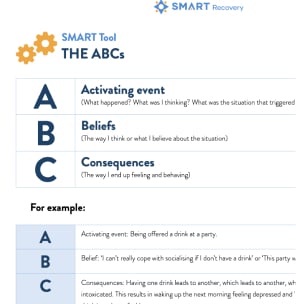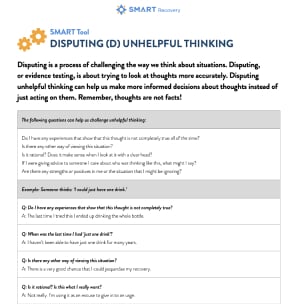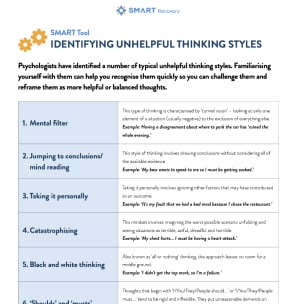Balancing the Scales: Insightful Revelations from the Cost-Benefit Analysis in Recovery
Change is born from understanding. In the journey of recovery, a deep, insightful understanding is often sparked when we honestly assess the full scope of our addictive behaviors. This isn't about judgment; it's about clarity, insight, and, ultimately, empowerment. SMART Recovery's Cost-Benefit Analysis (CBA) tool stands as a lighthouse in this explorative process. The CBA guides participants through an honest, structured evaluation of the benefits and costs of their actions, culminating in an "a-ha" moment that often ignites the flame of meaningful change.
Understanding the CBA
The CBA is a deceptively simple yet profound exercise. It involves drafting a four-quadrant table to dissect the advantages and disadvantages of both engaging in and abstaining from addictive behaviors. This methodical approach paves the way for an objective appraisal, often unearthing startling truths about the real impacts of one's choices.
- Enumerating the Perceived Benefits
In the CBA, participants first jot down the benefits they believe their addictive behavior brings. This might encompass relief from stress, a surge of euphoria, an escape from pain, or a sense of connection. Acknowledging these benefits is essential, as it illuminates the reasons the behavior may have taken root.
- Facing the Costs
Next, it's time to confront the costs of maintaining their addictive behavior. This exploration spans a spectrum of effects, from health complications, fractured relationships, financial strain, and legal issues, to an overall decline in quality of life.
- Appreciating the Benefits of Abstinence
Identifying the unique benefits that come with abstaining from the addictive behavior often reveals positive outcomes that extend beyond simply avoiding the negative impacts of engagement. These benefits may include improved physical health and energy, the ability to form deeper and more meaningful relationships, a renewed sense of self-esteem, the freedom to pursue new interests and hobbies, and the mental clarity and focus necessary to achieve personal and professional goals.
- Considering the Costs of Abstinence
The next quadrant prompts participants to ponder the potential costs associated with abstaining from the addictive behavior. These might include the discomfort of withdrawal, the challenge of finding new coping mechanisms, the fear of facing underlying issues, and the emotional toll of moving on from friendships that revolved around the addictive behavior. Recognizing these costs is crucial, as it prepares individuals for the realities of the recovery journey.
- Weighing the Four Quadrants: The "A-Ha" Moment
Upon completion of the four quadrants, participants step back to weigh and compare all aspects documented. It's in this reflective process that the compelling "a-ha" moment often occurs, as individuals clearly see that the long-term costs of engaging in their behavior far outweigh any temporary benefits, and that the mostly short-term costs of abstinence are indeed investments in a more fulfilling future.
Conclusion: From Insight to Action
The CBA transcends a mere reflective exercise; it's a catalyst for empowerment. By starkly illuminating the realities of addictive behaviors, it prompts a profound shift in perception. This shift, often experienced as an "a-ha" moment, marks a watershed in the recovery journey. It's the point where participants realize that true well-being and happiness are rooted in enduring the temporary costs of abstinence for a future that's richer and more fulfilling. The CBA doesn't erase the challenges ahead, but it bestows clarity and motivation, fueling the journey forward, one deliberate step at a time.
Helpful Links
Related Tools
View all- Worksheet
Change Plan
The change plan worksheet captures and organizes essential elements of a plan, including desired changes, reasons, steps, helpers, success indicators, and obstacles.
- Worksheet
HOV: Hierarchy of Values
In the throes of addiction, it's not uncommon for individuals to feel disconnected from what truly matters most to them. Activities, relationships, and principles that once held significant importance might have taken a back seat to the pursuit of addictive behaviors. SMART Recovery's Hierarchy of Values (HOV) tool is designed to bridge this gap, helping you reconnect with your authentic self and realign your daily actions with your deepest values.
- Worksheet
VACI: Vital Absorbing Creative Interest
Overcoming addictive behaviors is a journey that involves more than just abstaining from substances or detrimental habits. It's about rediscovering yourself, finding joy, and engaging in activities that provide a deep sense of fulfillment and purpose. This is where SMART Recovery's VACI tool comes into play. VACI, or Vitally Absorbing Creative Interest, isn't just a fancy term; it's a beacon of hope, a way to rediscover passion and joy in life beyond addiction's confines.
Tool Overview
The ABC Model is a good way of understanding how we can help change our feelings and behaviour by challenging our thinking.
When to Use This Tool
The ABC Model is a good way of understanding how we can help change our feelings and behaviour by challenging our thinking. It helps us uncover beliefs that are not helping us /contributing to the behaviour we are trying to change.
This exercise may be done in the group setting but can also be very useful for participants to look at between meetings.
How To Use This Tool
When working with urges: To analyze a lapse/relapse or to develop coping statements for an anticipated lapse/relapse.
In the event of a lapse, the question to ask is not “What made me do that”, but rather, “How did I talk myself into it?” It is not the urge (A) that causes the lapse (C). It is our beliefs (B); our irrational self-talk.With emotional upset:
The ABC Model can also be used to work with emotional upset or frustrations that may occur at any point in the recovery journey. The ABCs allow us to discover our unhelpful beliefs which contribute to emotional upsets. Disputing helps us eliminate our irrational thinking so we can both feel better and do better. In SMART Recovery we teach that we feel the way we think; it’s not unpleasant events that disturb us, it’s the way we think of them. By changing our thinking, we change how we feel.Identifying and Disputing Unhelpful Thinking.
Disputing is a process of challenging the way we think about situations. It’s about trying to look at thoughts more accurately. Disputing unhelpful thinking can help us make more informed decisions about thoughts instead of just acting on them. Balanced thinking leads to effective new beliefs.


